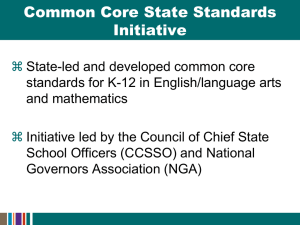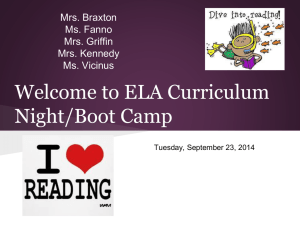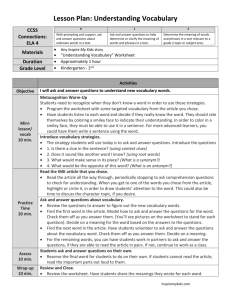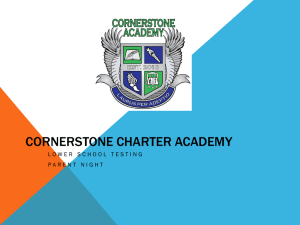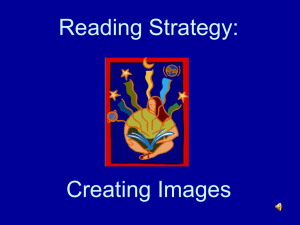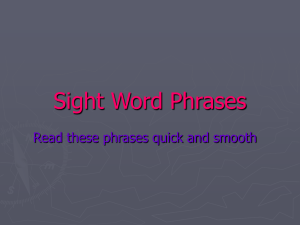West Haven Public Schools Unit Planning Organizer
advertisement
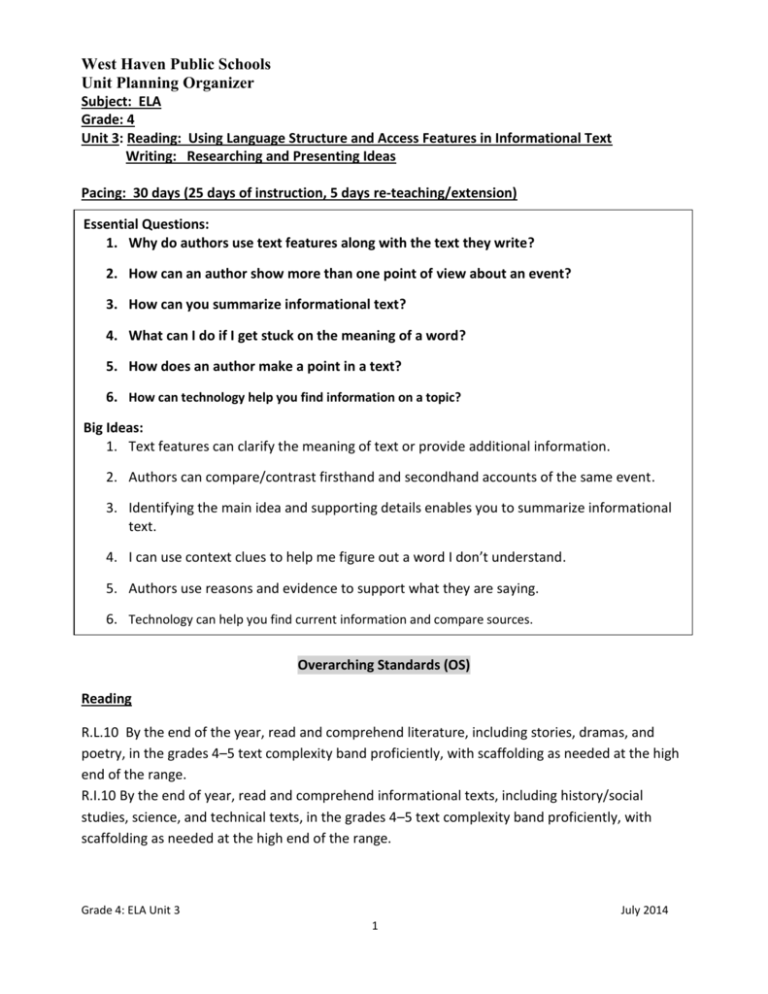
West Haven Public Schools Unit Planning Organizer Subject: ELA Grade: 4 Unit 3: Reading: Using Language Structure and Access Features in Informational Text Writing: Researching and Presenting Ideas Pacing: 30 days (25 days of instruction, 5 days re-teaching/extension) Essential Questions: 1. Why do authors use text features along with the text they write? 2. How can an author show more than one point of view about an event? 3. How can you summarize informational text? 4. What can I do if I get stuck on the meaning of a word? 5. How does an author make a point in a text? 6. How can technology help you find information on a topic? Big Ideas: 1. Text features can clarify the meaning of text or provide additional information. 2. Authors can compare/contrast firsthand and secondhand accounts of the same event. 3. Identifying the main idea and supporting details enables you to summarize informational text. 4. I can use context clues to help me figure out a word I don’t understand. 5. Authors use reasons and evidence to support what they are saying. 6. Technology can help you find current information and compare sources. Overarching Standards (OS) Reading R.L.10 By the end of the year, read and comprehend literature, including stories, dramas, and poetry, in the grades 4–5 text complexity band proficiently, with scaffolding as needed at the high end of the range. R.I.10 By the end of year, read and comprehend informational texts, including history/social studies, science, and technical texts, in the grades 4–5 text complexity band proficiently, with scaffolding as needed at the high end of the range. Grade 4: ELA Unit 3 July 2014 1 Writing W.4 Produce clear and coherent writing in which the development and organization are appropriate to task, purpose, and audience. W.6 With some guidance and support from adults, use technology, including the Internet, to produce and publish writing as well as to interact and collaborate with others; demonstrate sufficient command of keyboarding skills to type a minimum of one page in a single sitting. W.10 Write routinely over extended time frames (time for research, reflection, and revision) and shorter time frames (a single sitting or a day or two) for a range of discipline-specific tasks, purposes, and audiences. Speaking and Listening SL.1 Engage effectively in a range of collaborative discussions (one-on-one, in groups, and teacher led) with diverse partners on grade 4 topics and texts, building on others’ ideas and expressing their own clearly. Language L.1 Demonstrate command of the conventions of standard English grammar and usage when writing or speaking. L.2 Demonstrate command of the conventions of standard English capitalization, punctuation, and spelling when writing. L.2.a Use correct capitalization L.2.d Spell grade-appropriate words correctly, consulting references as needed. L.3 Use knowledge of language and its conventions when writing, speaking, reading, or listening. Foundational Skills R.F.3 Know and apply grade-level phonics and word analysis skills in decoding words R.F.4 Read with sufficient accuracy and fluency to support comprehension Grade 4: ELA Unit 3 July 2014 2 Common Core State Standards (includes West Haven’s “Priority” Common Core Standards in BOLD and “Supporting” Standards) Priority Standards: R.I.2 Determine the main idea of a text and explain how it is supported by key details; summarize the text. R.I.6 Compare and contrast a firsthand and secondhand account of the same event or topic; describe the differences in focus and the information provided. R.I.7 Interpret information presented visually, orally, or quantitatively (e.g., in charts, graphs, diagrams, time lines, animations, or interactive elements on Web pages) and explain how the information contributes to an understanding of the text in which it appears. R.I.8 Explain how an author uses reasons and evidence to support particular points in a text. R.I.9 Integrate information from two texts on the same topic in order to write or speak about the subject knowledgeably. W.5 With guidance and support from peers and adults, develop and strengthen writing as needed by planning, revising, and editing. W.2.a Introduce a topic clearly and group related information in paragraphs and sections; including formatting (e.g., headings), illustration, and multimedia when useful to aiding comprehension. W.2.b Develop the topic with facts, definitions, concrete details, quotations, or other information and examples related to the topic. W.2.d Use precise language and domain specific vocabulary to inform about or explain a topic. W.9 Draw evidence from literary or informational texts to support analysis, reflection, and research. SL.2 Paraphrase portions of a text read aloud or information presented in diverse media and formats, including visually, quantitatively, and orally. L.1.e Form and use prepositional phrases. L.3.a Choose words and phrases to convey ideas precisely. L.4.a Use context (e.g., definitions, examples, or restatements in text) as a clue to the meaning of a word or phrase. RF.4.a Read on-level text with purpose and understanding. Supporting Standards: R.I.4 Determine the meaning of general academic and domain-specific words or phrases in a text relevant to a grade 4 topic or subject area W.2.c Link ideas within categories or information using words and phrases (e.g., another, for example, also, because). Grade 4: ELA Unit 3 July 2014 3 W.2.e Provide a concluding statement or section related to the information or explanation presented. W.7 Conduct short research projects that build knowledge through investigation of different aspects of a topic. W.8 Recall relevant information from experiences or gather relevant information from print and digital sources; take notes and categorize information, and provide a list of sources. L.4 Determine or clarify the meaning of unknown and multiple words and phrases base on grade 4 reading and content, choosing flexibly from a range of strategies. L.4.c Consult reference materials (e.g., dictionaries, glossaries, thesauruses), both print and digital, to find the pronunciation and determine or clarify the precise meaning of key words and phrases. SL.1.d Review the key ideas expressed and explain their own ideas and understanding in light of the discussion. SL.5 Add audio recordings and visual displays to presentations when appropriate to enhance the development of main ideas or themes “Unwrapped” Concepts and Skills, and Bloom Levels (BL) Concepts(Need to Know) R.I.2 Main idea Key details R.I.6 Compare and contrast accounts Event Topic R.I.7 Presentation of Information Visual, oral, or quantitatively Charts Graphs Diagrams Time lines Animations Interactive elements Contribution to text R.I.8 Explain how reasons and evidence are used to support point R.I.9 Information from two texts Knowledgeable about subject Skills(Able to Do) BL R.I.2 DETERMINE 3 R.I.6 COMPARE (accounts) 4 R.I.7 INTERPRET(information) 4,6 EXPLAIN(contribution to the text) 5,6 R.I.8 EXPLAIN(reasons and evidence) 3 R.I.9 INTEGRATE WRITE/SPEAK Grade 4: ELA Unit 3 5 3 July 2014 4 W.5 Peer editing W.2.a Write topic clearly to aid comprehension Paragraphs Sections Headings Illustrations W.5 DEVELOP and STRENGTHEN (writing as needed) W.2.a INTRODUCE(topic) W.2.b Facts Definitions Concrete details quotations W.2.d Explain topic Precise language Domain specific vocabulary W.9 Find Evidence Literary Informational text SL.2 Portions of text (diverse media/formats) L.1.e Use prepositional phrases L.3.a Words/phrases Precise ideas L.4.a Use context to determine meaning Definitions Examples Restatements W.2. b 5 2 2 GROUP(related information in paragraph/sections) INCLUDE(formatting, illustrations, multimedia) 6 DEVELOP W.2.d 3 2 USE(language) INFORM(about a topic) 2 EXPLAIN(the topic) W.9 6 DRAW (evidence to support analysis, reflection, research SL.2 Paraphrase L.1.e 2 USE(prepositional phrases) 3 L.3.a CHOOSE CONVEY L.4.a Infer(meaning) 3 2 4 Assessments “Dipsticks” (Informal Progress Monitoring Checks): Teacher created Common Post- Assessment (Followed by Data Team Analysis): Unit 3 Post CA – “The Amazing Amazon” Retest (based on student’s Post CA score): 1 Retest - “Deserts Dry” Grade 4: ELA Unit 3 July 2014 5 Writing Performance Task - Expository Writing Refer to Rigorous Curriculum Design: Engaging Learning Experiences Planner Part 1 (approximately 1 hr.): Students Read and Respond to three evidenced-based research questions Part 2 (approximately 1 hr.): Students will develop a full-write response using the same source material in part 1 – refer to Smarter Balanced Performance Task Scoring Guide Vocabulary: Wordly Wise Use teacher guide to find 2 options for assessment; multiple choice or Review Spelling: Words Their Way-Word Sorts for Derivational Relations Spellers Assess weekly Choose 15 words each week Then choose 10 words from sorts for teacher created sentence dictation test Language: Daily Oral Language (Teacher Created Assessments) Grade 4: ELA Unit 3 July 2014 6 Instructional Planning ELA: Week 1 SHARED READING *Refer to Nancy Boyles’ Launching Lessons for Modeling Close Reading (included in Unit 1) What Do Good Readers Do? Model Before, During, After Reading Strategies during Shared Reading and Read Aloud IMPORTANT Shared Reading Strategies: The focus of shared reading is not based on the Scott Foresman skill of the week. For any resources that you use during Shared Reading make sure to focus your instruction on the following CT CORE Standards. Determine the main idea of a text and explain how it is supported by key details; summarize the text. Compare and contrast a firsthand and secondhand account of the same event or topic; describe the differences in focus and the information provided. Interpret information presented visually, orally, or quantitatively (e.g., in charts, graphs, diagrams, time lines, animations, or interactive elements on Web pages) and explain how the information contributes to an understanding of the text in which it appears. Explain how an author uses reasons and evidence to support particular points in a text. Integrate information from two texts on the same topic in order to write or speak about the subject knowledgeably Scott Foresman Textbook Komodo Dragons (p. 232-249) Rattlers by Robert Charles (www.readinga-z.com) (copied by the district) GUIDED READING Scott Foresman Leveled Readers The Perfect Garden - 100A Horned Lizard - 100B www.readinga-z.com (Leveled Readers) Leveled Readers in Bookroom INDEPENDENT READING DAILY 5 – Read to Self Grade 4: ELA Unit 3 July 2014 7 *Vocabulary and Spelling should be taught in a small group setting based on students’ needs. Vocabulary: Wordly Wise 3000 A-Z Readers Spelling: Administer Words Their Way-Elementary Spelling Inventory (ESI) Utilize Words Their Way-Word Sorts for Syllables and Affixes Language: (*Use World of Language only if it applies to the language standards being taught in this unit. o Form and use prepositional phrases. o Choose words and phrases to convey ideas precisely. o Use context (e.g., definitions, examples, or restatements in text) as a clue to the meaning of a word or phrase. Writing Expository Writing- refer to Writing binder Grade 4: ELA Unit 3 July 2014 8 Instructional Planning ELA: Week 2 SHARED READING *Refer to Nancy Boyles’ Launching Lessons for Modeling Close Reading (included in Unit 1) What Do Good Readers Do? Model Before, During, After Reading Strategies during Shared Reading and Read Aloud IMPORTANT Shared Reading Strategies: The focus of shared reading is not based on the Scott Foresman skill of the week. For any resources that you use during Shared Reading make sure to focus your instruction on the following CT CORE Standards. Determine the main idea of a text and explain how it is supported by key details; summarize the text. Compare and contrast a firsthand and secondhand account of the same event or topic; describe the differences in focus and the information provided. Interpret information presented visually, orally, or quantitatively (e.g., in charts, graphs, diagrams, time lines, animations, or interactive elements on Web pages) and explain how the information contributes to an understanding of the text in which it appears. Explain how an author uses reasons and evidence to support particular points in a text. Integrate information from two texts on the same topic in order to write or speak about the subject knowledgeably Reading A-Z Natural Wonders of the World (www.readinga-z.com) (copied by the district) GUIDED READING www.readinga-z.com (Leveled Readers) Leveled Readers in Bookroom INDEPENDENT READING DAILY 5 – Read to Self Grade 4: ELA Unit 3 July 2014 9 *Vocabulary and Spelling should be taught in a small group setting based on students’ needs. Vocabulary: Wordly Wise 3000 A-Z Readers Spelling: Administer Words Their Way-Elementary Spelling Inventory (ESI) Utilize Words Their Way-Word Sorts for Syllables and Affixes Language: (*Use World of Language only if it applies to the language standards being taught in this unit. o Form and use prepositional phrases. o Choose words and phrases to convey ideas precisely. o Use context (e.g., definitions, examples, or restatements in text) as a clue to the meaning of a word or phrase. Writing Expository Writing- refer to Writing binder Grade 4: ELA Unit 3 July 2014 10 Instructional Planning ELA: Week 3 SHARED READING *Refer to Nancy Boyles’ Launching Lessons for Modeling Close Reading (included in Unit 1) What Do Good Readers Do? Model Before, During, After Reading Strategies during Shared Reading and Read Aloud IMPORTANT Shared Reading Strategies: The focus of shared reading is not based on the Scott Foresman skill of the week. For any resources that you use during Shared Reading make sure to focus your instruction on the following CT CORE Standards. Determine the main idea of a text and explain how it is supported by key details; summarize the text. Compare and contrast a firsthand and secondhand account of the same event or topic; describe the differences in focus and the information provided. Interpret information presented visually, orally, or quantitatively (e.g., in charts, graphs, diagrams, time lines, animations, or interactive elements on Web pages) and explain how the information contributes to an understanding of the text in which it appears. Explain how an author uses reasons and evidence to support particular points in a text. Integrate information from two texts on the same topic in order to write or speak about the subject knowledgeably Scott Foresman Textbook Understanding Horses p. 41-43 Hoofed Animals (www.readinga-z.com) (copied by the district) GUIDED READING www.readinga-z.com (Leveled Readers) Leveled Readers in Bookroom INDEPENDENT READING DAILY 5 – Read to Self Grade 4: ELA Unit 3 July 2014 11 *Vocabulary and Spelling should be taught in a small group setting based on students’ needs. Vocabulary: Wordly Wise 3000 A-Z Readers Spelling: Administer Words Their Way-Elementary Spelling Inventory (ESI) Utilize Words Their Way-Word Sorts for Syllables and Affixes Language: (*Use World of Language only if it applies to the language standards being taught in this unit. o Form and use prepositional phrases. o Choose words and phrases to convey ideas precisely. o Use context (e.g., definitions, examples, or restatements in text) as a clue to the meaning of a word or phrase. Writing Expository Writing- refer to Writing binder Grade 4: ELA Unit 3 July 2014 12 Instructional Planning ELA: Week 4 SHARED READING *Refer to Nancy Boyles’ Launching Lessons for Modeling Close Reading (included in Unit 1) What Do Good Readers Do? Model Before, During, After Reading Strategies during Shared Reading and Read Aloud IMPORTANT Shared Reading Strategies: The focus of shared reading is not based on the Scott Foresman skill of the week. For any resources that you use during Shared Reading make sure to focus your instruction on the following CT CORE Standards. Determine the main idea of a text and explain how it is supported by key details; summarize the text. Compare and contrast a firsthand and secondhand account of the same event or topic; describe the differences in focus and the information provided. Interpret information presented visually, orally, or quantitatively (e.g., in charts, graphs, diagrams, time lines, animations, or interactive elements on Web pages) and explain how the information contributes to an understanding of the text in which it appears. Explain how an author uses reasons and evidence to support particular points in a text. Integrate information from two texts on the same topic in order to write or speak about the subject knowledgeably Reading A-Z The Sun by Ned Jensen (www.readinga-z.com) (copied by the district) GUIDED READING www.readinga-z.com (Leveled Readers) Leveled Readers in Bookroom INDEPENDENT READING DAILY 5 – Read to Self Grade 4: ELA Unit 3 July 2014 13 *Vocabulary and Spelling should be taught in a small group setting based on students’ needs. Vocabulary: Wordly Wise 3000 A-Z Readers Spelling: Administer Words Their Way-Elementary Spelling Inventory (ESI) Utilize Words Their Way-Word Sorts for Syllables and Affixes Language: (*Use World of Language only if it applies to the language standards being taught in this unit. o Form and use prepositional phrases. o Choose words and phrases to convey ideas precisely. o Use context (e.g., definitions, examples, or restatements in text) as a clue to the meaning of a word or phrase. Writing Expository Writing- refer to Writing binder Practice: Read two sources on the same topic (InfoPairs in bookroom) or view a video (TumbleBooks online) and read a source on the same topic. Write an expository piece stating what you learned about the topic. Grade 4: ELA Unit 3 July 2014 14 Instructional Planning ELA: Week 5 Administer Post CA- “The Amazing Amazon” SHARED READING *Refer to Nancy Boyles’ Launching Lessons for Modeling Close Reading (included in Unit 1) What Do Good Readers Do? Model Before, During, After Reading Strategies during Shared Reading and Read Aloud IMPORTANT Shared Reading Strategies: The focus of shared reading is not based on the Scott Foresman skill of the week. For any resources that you use during Shared Reading make sure to focus your instruction on the following CT CORE Standards. Determine the main idea of a text and explain how it is supported by key details; summarize the text. Compare and contrast a firsthand and secondhand account of the same event or topic; describe the differences in focus and the information provided. Interpret information presented visually, orally, or quantitatively (e.g., in charts, graphs, diagrams, time lines, animations, or interactive elements on Web pages) and explain how the information contributes to an understanding of the text in which it appears. Explain how an author uses reasons and evidence to support particular points in a text. Integrate information from two texts on the same topic in order to write or speak about the subject knowledgeably Scott Foresman: Komodo Dragons p. 232-249 Reading A-Z: Rattlers GUIDED READING www.readinga-z.com (Leveled Readers) Leveled Readers in Bookroom INDEPENDENT READING DAILY 5 – Read to Self Grade 4: ELA Unit 3 July 2014 15 *Vocabulary and Spelling should be taught in a small group setting based on students’ needs. Vocabulary: Wordly Wise 3000 A-Z Readers Spelling: Administer Words Their Way-Elementary Spelling Inventory (ESI) Utilize Words Their Way-Word Sorts for Syllables and Affixes Language: (*Use World of Language only if it applies to the language standards being taught in this unit. o Form and use prepositional phrases. o Choose words and phrases to convey ideas precisely. o Use context (e.g., definitions, examples, or restatements in text) as a clue to the meaning of a word or phrase. Writing Performance Task – Expository Writing (Part 1 = Tasks 1 & 2) (Part 2 = Tasks 3) Grade 4: ELA Unit 3 July 2014 16 Instructional Planning ELA: Week 6 Performance Task 5 continued: Creating your book (Refer to Rigorous Curriculum Design: Engaging Learning Experiences Planner) Re-teaching and Enrichment based on Assessments Extension Further research finding out more about deserts and rainforests in the world. Compare and contrast deserts and rainforests. Interdisciplinary Science: Nonfiction Study of Science Text Features Grade 4: ELA Unit 3 July 2014 17 Suggested Research-based Effective Instructional Strategies: RESEARCH-BASED EFFECTIVE TEACHING STRATEGIES Strategy Suggestions for How to Use Strategy 1 Multiple intelligences 1 Non-Fiction Writing Use engaging text for students to practice inter-disciplinary writing KWL Chart (what do we already know, what do we want to find out, what did we learn) Venn diagram Compare and contrast Word and Number webs 2 3 Graphic organizers Provide support resources (manipulative, visual aids, charts, outlines, picture cues, audiotape books and instructions) Vary assessment types (i.e. performance task, open response, multiple choice, etc) Vocabulary/Word Wall Lesson 5: Abrupt - happening suddenly, without warning Achieve - to do what one sets out to do Attempt - to try; to make an effort Contempt - a feeling that someone or something is bad or unworthy Entertain - to interest and amuse Glimpse - to get a quick look at Mock - to make fun of Grade 4: ELA Unit 3 July 2014 18 Persist - to keep on doing or trying Persuade - to win someone over by arguing or asking Phase - a stage in a series of changes Quaint - odd or unusual in a pleasing or old-fashioned way Recall - to remember Reject - to refuse to accept or use Revise - to go over carefully in order to correct or improve Sensitive - quick to notice or feel Lesson 6: Applaud - to show approval, especially by clapping hands Crafty - skilled at tricking others Disclose - to make known Drab - dull and without color; not cheerful or colorful Entire - having nothing left out; whole; complete Exclaim - to speak suddenly and with strong feeling Exquisite - finely done or made; very beautiful Intend - to plan; to have in mind Jeer - to speak or cry out in scorn; to mock Peer - to look closely; to stare, especially at something that is hard to see or to understand Progress - moving toward a goal Refine - to make pure by removing all unwanted matter Scoundrel - a mean or wicked person Uneasy - not comfortable, worried or nervous Vain - having too high an opinion of one’s looks or achievements Additional Vocabulary: Presented - information given or offered in a text Varies – how something differs; contrast Grade 4: ELA Unit 3 July 2014 19
